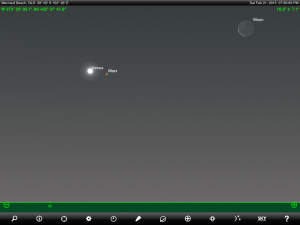(Posted 21 February 2015)

If you are lucky enough to have clear skies tonight, look low above the Western horizon in the evening twilight to locate a slim crescent Moon plus the planets Venus and Mars. If the sky becomes dark enough before the Moon sets, you will notice that the ‘night’ or un-illuminated side of the Moon is faintly illuminated by ‘Earth shine‘.
I know very little about astronomy except I love the night sky. Embarrassed to admit I can’t even use a telescope but the first time I saw Saturn through a friend’s I thought I was dreaming. My balcony looks west and I googled the 2 “stars” closest to the crescent moon. Venus and Mars. That is so exciting. I must sound so pathetic to some of you!
Helen,
Great to hear from you. It is indeed a beautiful view. And no, I am glad you find it exciting also. I have been looking at the heavens for some 30 plus years and still love seeing this type of event.
Speaking of Saturn, have you seen the latest images returned by NASA’s Cassini mission which is currently orbiting Saturn? It has recently completed a flyby of Dione (one of Saturn’s moons) and the images are spectacular. You can find them here: http://saturn.jpl.nasa.gov/news/newsreleases/newsrelease20150618/
Regards,
Paul Floyd.